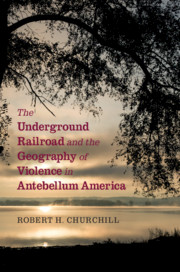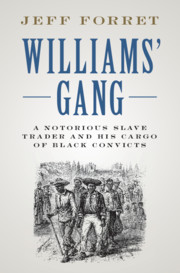The Underground Railroad and the Geography of Violence in Antebellum America
As runaway slaves fled from the South to escape bondage, slave catchers followed in their wake. The arrival of fugitives and slave catchers in the North set off violent confrontations that left participants and local residents enraged and embittered. Historian Robert H. Churchill places the Underground Railroad in the context of a geography of violence, a shifting landscape in which clashing norms of violence shaped the activities of slave catchers and the fugitives and abolitionists who defied them. Churchill maps four distinct cultures of violence: one that prevailed in the South and three more in separate regions of the North: the Borderland, the Contested Region, and the Free Soil Region. Slave catchers who followed fugitives into the North brought with them a Southern culture of violence that sanctioned white brutality as a means of enforcing racial hierarchy and upholding masculine honor, but their arrival triggered vastly different violent reactions in the three regions of the North. Underground activists adapted their operations to these distinct cultures of violence, and the cultural collisions between slave catchers and local communities transformed Northern attitudes, contributing to the collapse of the Fugitive Slave Act and the coming of the Civil War.
- Divides patterns of behavior and attitudes toward abolition into three Northern regions determined by their distance to the South
- Stresses the cultural and political implications of these divisions as decisive factors that led to the Civil War
- Introduces the concept of a culture of violence to better contextualize the conflicts between slave catchers and antislavery crowds
Reviews & endorsements
‘Churchill's portrayal of the ways in which the distinctively Southern culture of violence alienated Northern communities subject to invasion by slave catchers is exceptionally acute. Churchill has made a lasting contribution to the history of the complex phenomenon that was the Underground Railroad, the nation's first civil rights movement.' Fergus Bordewich, author of Bound for Canaan: The Underground Railroad and the War for the Soul of America
‘Original, thoroughly and comprehensively researched, well written, and tightly argued.' Steven Lubet, author of The 'Colored Hero' of Harpers Ferry
‘A significant contribution to the literature on the Underground Railroad.' Graham Hodges, George Dorland Langdon, Jr Professor of History and Africana and Latin American Studies, Colgate University, New York
‘Using court records, print media, and memoirs, Churchill depicts the pervasive nature of the violence that defined the relationship between fugitive slaves, bounty hunters, abolitionists, and the great many Northerners who wished no association with the culture of slavery.’ S. L. Smith, Choice
‘Considered together with the hundreds of individual stories of African American migrants and their interracial associates, this rich travel narrative framed by violence, intrigue, and self-determination enriches our understanding of the antebellum period.' Timothy Fritz, The Portolan
‘… excellent analysis … the book demonstrates that the movement operated within a diverse 'geography of violence,' which shaped the responses of northern whites. The Underground Railroaddraws insightful connections between geographically disparate regions through the lens of cultural violence.’ Oran Patrick Kennedy, American Nineteenth Century History
Product details
February 2020Paperback
9781108733465
236 pages
227 × 152 × 15 mm
0.39kg
11 maps 1 table
Available
Table of Contents
- Part I. Origins to 1838:
- 1. Refugees all: the origins of the Underground Railroad
- Part II. 1838–1850:
- 2. Under siege: borderland activists confront the violence of mastery
- 3. Bondage and dignity: accommodation and collision in the contested region
- 4. Free soil: Prigg, Latimer, and open resistance in the upper north
- Part III. 1850–1860:
- 5. Law and degradation: lethal violence and beleaguered resistance in the borderland
- 6. Above ground: open defiance and the limits of free soil
- 7. The end of toleration: the collapse of the Fugitive Slave Act in the contested region
- Epilogue: cultures of violence, secession, and war
- Appendix: fugitive slave rescues, 1794–1861.



